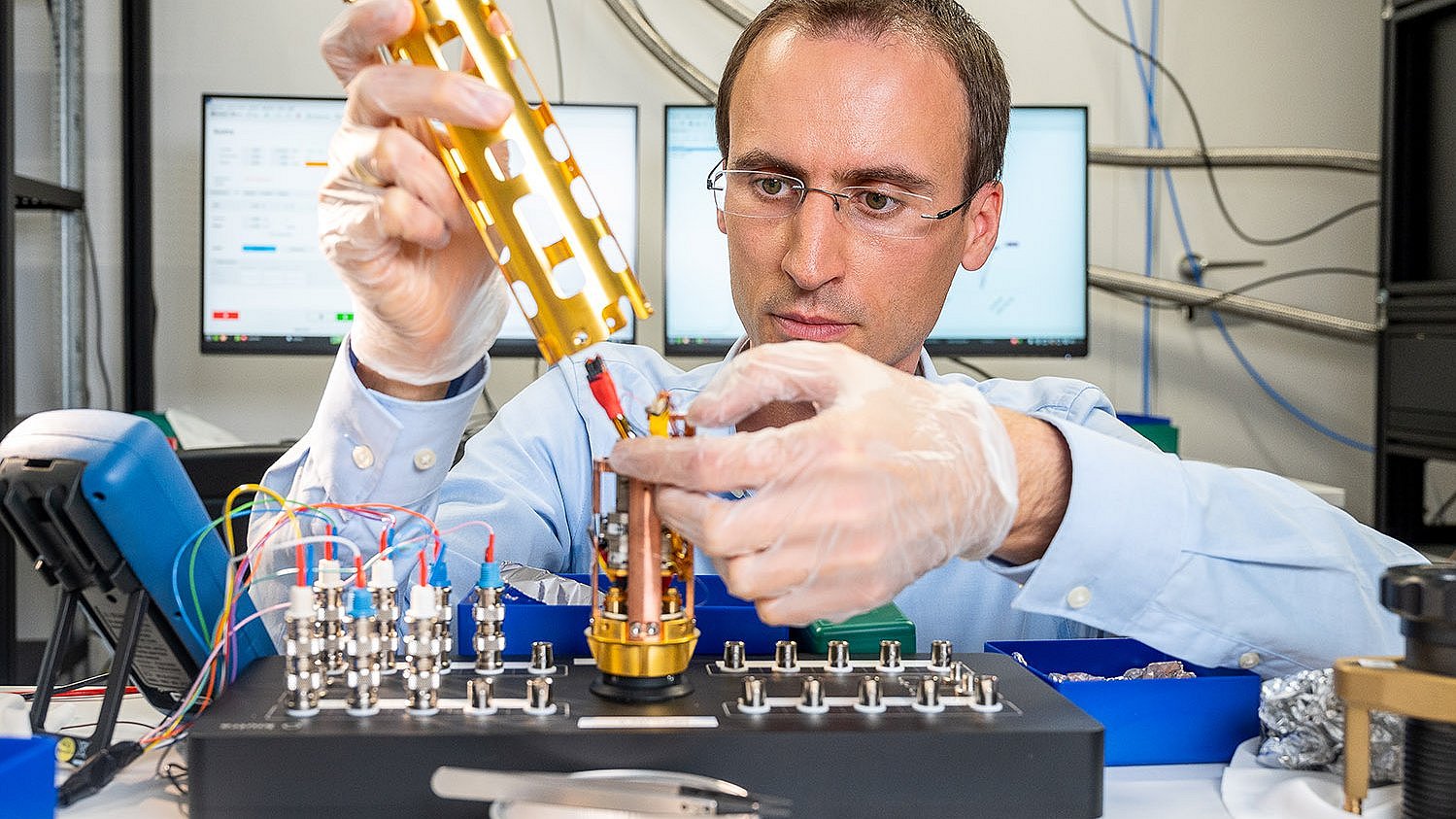Researchers around the world are working on a network which could connect quantum computers with one another over long distances. Andreas Reiserer, Professor of Quantum Networks at the Technical University of Munich (TUM), explains the challenges which have to be mastered and how atoms captured in crystals can help.
 Astrid Eckert / TUM
Astrid Eckert / TUM Professor Reiserer, what is the quantum internet and how is it different from the classical internet as we know it?
The idea is the same: We use today's internet to connect computers with one another, while the quantum internet lets quantum computers communicate with one another. But in technical terms the quantum internet is much more complex. That's why only smaller networks have been realized as yet.
Why do we need a quantum network?
There are two main applications: First of all, networking quantum computers makes it possible to increase their computing power; second, a quantum network will make absolutely interception-proof encryption of communication possible. But there are other applications as well, for example networking telescopes to achieve a previously impossible resolution in order to look into the depths of the universe, or the possibility of synchronizing atomic clocks around the world extremely precisely, making it possible to investigate completely new physical questions.
How do quantum computers exchange information?
For the most part, exactly the same way as in the classical internet: Using photons. These photons are transmitted through optical cables. In the classical internet very strong signals are used, light pulses consisting of billions of photons. Here the information is transmitted using a binary code: Light on or light off, similar to Morse code. The quantum internet is different, though: It still uses a binary code, but the information isn't carried by light impulses with many photons, but rather by individual photons. This makes it possible to transmit quantum-mechanical states which bear extremely large amounts of information.
Why is it so much more difficult to build a quantum internet?
Photons are lost on their way through the optical cable. In a normal network signals can be easily amplified using repeaters which add more photons to the light pulses. But in the quantum internet if a single photon gets lost, all of the information transmitted is irretrievably destroyed. This kind of loss is the biggest problem when building a functional network. It could be solved using quantum repeaters, which my group is currently working on.
Display external content
At this point content of an external provider (source: www.xyz.de) is integrated. When displaying, data may be transferred to third parties or cookies may be stored, therefore your consent is required.
You can find more information and the possibility to revoke your consent at www.tum.de/datenschutz.
I agree
What challenges do you face?
Transmission over short distances already works very well. However, loss grows exponentially as distances increase. In order to build quantum repeaters, we split the overall distance into many small sub-segments. Buffers, actually small quantum computers, store the quantum state after each sub-segment until a photon has been transmitted to the next sub-segment. Then what's known as quantum teleportation can be used to subsequently "forward" the information to the transmitted photon. Doing this requires efficient small quantum computers, which we're in the process of developing.
What do these small quantum computers look like?
The best systems investigated yet use individual atoms which are captured in vacuum with laser light and cooled down to very low temperatures. However, this approach calls for an entire laboratory full of optical components, which makes it difficult to implement this approach on a small scale. Instead we use silicon crystals in which the individual atoms have been inserted and you could say are trapped in the crystal. The erbium atoms we use retain their quantum-mechanical properties under these conditions. This structure also requires low temperatures, but it's technically much, much simpler. We've been able to show that this system works in principle and that the erbium atoms, when they're excited, generate photons which are suitable for transporting quantum information. Here a major advantage is that we can build thousands or even millions of these structures on a single silicon chip.
Why is that important?
The need for buffering in the repeaters would mean it would take a very long time to transport information from one place to another. In order to achieve a faster rate, we use what's called multiplexing. This means the process is carried out as many times as possible in parallel. Our technology makes this feasible, and we're already working on realization.
Will we all be using the quantum internet in the future?
The situation may turn out to be similar to the classical internet: At first hardly anyone could imagine that today everyone would be walking around with internet access in their pockets, using satellites to determine our location and navigating using the internet. We're still at a very early stage as far as the quantum internet is concerned. Our current research is still on fundamentals, looking at things like: Can we connect these systems? Can we succeed in disseminating quantum states all over the world? The potentials of this kind of system that we know of today would already be revolutionary for some fields, and I'm sure there will be very many applications which nobody is even thinking of today.
- Andreas Gritsch, Lorenz Weiss, Johannes Früh, Stephan Rinner, and Andreas Reiserer, "Narrow Optical Transitions in Erbium-Implanted Silicon Waveguides", Phys. Rev. X 12, 041009
https://journals.aps.org/prx/abstract/10.1103/PhysRevX.12.041009
- Andreas Gritsch, Alexander Ulanowski, and Andreas Reiserer, "Purcell enhancement of single-photon emitters in silicon," Optica 10, 783-789 (2023)






